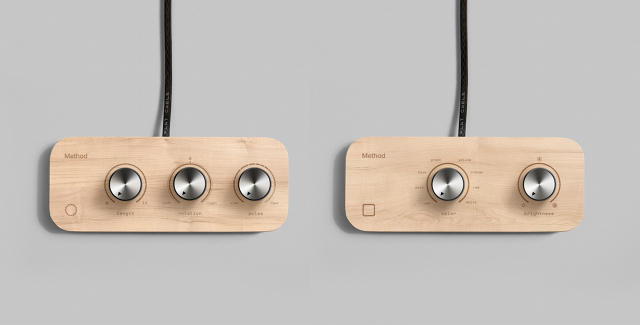Smart devices have created new problems for designers to solve, not least of which is interface: how does a gadget or appliance communicate to you when it doesn't have a screen? That's a problem that brand and design firm Method has been thinking a lot about lately, so much so that they created the Henri, an interactive gizmo that makes it easier for designers to explore the ambient UIs of future gadgets.
Henri is meant to function as an abstract stand-in for a connected home product like the Nest, the Philips Hue, or the Leeo Smart Alert. Two control panels of brushed steel knobs are connected to Henri, allowing designers to easily experiment with ambient interface elements without needing a ton of technical know-how: for example, what is the best pattern and color for LED lights to pulse in response to certain commands? Or what sounds should play under certain scenarios? Just by twisting these knobs, designers can create all sorts of light, sound, and halo patterns and figure it out.

"For the last 15 years, Method has mostly done screen-based design," says Method's Daniel Nacamuli, who led the Henri design team. "But with the rise of smart objects and the connected home, we've found that products increasingly need to communicate even without a screen, through things like light and sound patterns."
What Method found was there's no easy way to design this ambient language of softly pulsing light and sound. While a designer creating a graphical user interface for an app is perfectly comfortable loading up InDesign, creating bliking patterns for the LED on a Nest still requires a technical know-how that is out of reach for most designers.
Why do designers need a device like the Henri? When it comes to the ambient language of the way smart objects communicate their state to their users, it's total chaos out there. There are no best practices guides or style manuals. It's still a period of trial and error experimentation. If you think about the symbology of other products, the grammar is relatively static: when dealing with any interface dedicated to listening to music, a triangle turned on its side means 'Play.'

But there's no accepted vernacular for what the ambient light and sound signals coming out of smart objects means: if your GoPro starts blinking a red LED at you, does that mean it's recording, or that it's running out of battery? "It's something designers really need to think about: what happens when you have all these connected objects in your house that all communicate with their users differently?" Nacamuli says.
And Henri only represent's one part of Method's efforts to generate interest in the design of ambient interfaces: the firm originally unveiled the Henri box as part of a workshop in December at San Francisco's IxDA conference, where attendees were paired in teams and asked to program light and sound patterns on the Henri to communicate test scenarios, such as conveying how a smart door might tell a user that an annoying solicitor was walking up to the door, or how to reflect a whimsical personality for a brand through patterns of flashing lights.
The exercise yielded some important lessons: for example, increasing the speed of a flashing light or blipping sound to communicate urgency is intuitive to just about everyone; we also have cultural expectations for certain colors to be used to communicate certain states, like red as a warning color. But as far as a universal language for smart objects goes, it's still many years off.
That's okay, says Nacamuli. Traditional GUIs don't all communicate the same rules either, but at the very least they have pop-ups and tooltips associated with them that explain what they do. The challenge facing designers is to figure out how to make the design language of tomorrow's ambient gadgets intuitive without tooltips and pop-ups. The point of the Henri is to let designers get their hands dirty as they figure it out, raising awareness of the challenges that face designers and consumers alike as traditionally 'dumb' gadgets start trying to communicate with us through blips of sound and light. The Henri is like a Rosetta Stone, allowing us to try and decode the ambient interfaces of tomorrow.